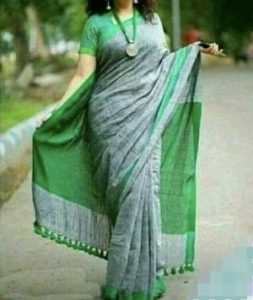Taant Saree
 Taant saree is a traditional handwoven saree that originates from the state of West Bengal in India. It is a quintessential Bengali saree and holds significant cultural and historical importance in the region. The term “Taant” refers to the weaving technique used to create these sarees, which involves a unique process of handloom weaving.
Taant saree is a traditional handwoven saree that originates from the state of West Bengal in India. It is a quintessential Bengali saree and holds significant cultural and historical importance in the region. The term “Taant” refers to the weaving technique used to create these sarees, which involves a unique process of handloom weaving.
Different regions of Bengal have developed their own unique styles of Taant saree. Each region has its distinct weaving techniques, designs, and motifs, making these sarees representative of the diverse cultural identity of Bengal.
Features of Taant Saree:
Fabric: Taant sarees are woven using cotton threads. They are lightweight and comfortable to wear, making them ideal for hot and humid weather.
Weaving Technique: The sarees are woven on traditional handlooms, often operated by skilled artisans who have inherited the craft through generations. The intricate weaving techniques result in beautiful patterns and designs on the saree.
Designs and Patterns: Taant sarees are available in various designs and patterns, ranging from simple and elegant styles to more elaborate and artistic ones. Common motifs found on Taant sarees include floral designs, butis (small motifs), geometric patterns, and traditional symbols.
Borders and Pallu: The borders and pallu (the decorative end of the saree) are an essential part of the Taantsaree’s beauty. They often feature contrasting colors and intricate patterns, enhancing the overall appeal of the saree.
also read about India Saress and Types
History of Taant Saree
Taant saree has its roots in the rich cultural heritage of Bengal, particularly in the regions of West Bengal and Bangladesh. The term “Taant” is derived from the Bengali word “taana,” which translates to “to weave.” This name reflects the essence of the saree, which is entirely woven by hand on traditional handlooms. The art of weaving Taant sarees can be traced back to the 15th century in the Shantipur district. During the Mughal period, cotton weaving flourished in Bengal due to the patronage of the local and Mughal rulers. The local weavers developed expertise in weaving lightweight and comfortable cotton fabrics, making them ideal for the tropical climate of the region.
In the 18th century, Bengal came under British rule, and the demand for Taant sarees grew significantly. The British encouraged the export of Taant sarees to various parts of India and even to international markets. The sarees gained popularity not only among Indian women but also among women in Southeast Asia and Europe.
Initially, Taant sarees featured simple designs and were woven in natural colors. Over time, the sarees evolved to incorporate more intricate patterns, vibrant colors, and stylized motifs. The designs are often inspired by nature, mythology, folklore, and other cultural elements, reflecting the heritage of Bengal.
Manufacturing of Taant sarees
 The creation of Taant sarees involves a traditional and labor-intensive handloom weaving process. Skilled artisans, often called “taantis,” use handlooms to meticulously weave these beautiful sarees. Here’s a detailed overview of how Taant sarees are made:
The creation of Taant sarees involves a traditional and labor-intensive handloom weaving process. Skilled artisans, often called “taantis,” use handlooms to meticulously weave these beautiful sarees. Here’s a detailed overview of how Taant sarees are made:
- Yarn Preparation: The process begins with the preparation of cotton yarn, which serves as the primary material for weaving Taant sarees. The cotton fibers are cleaned, carded, and spun into fine threads to ensure uniformity and strength.
- Warping: The next step is warping, where the yarn is arranged in parallel threads called “warp.” This process involves the precise measurement and alignment of threads to form the length of the saree.
- Dressing the Loom: Once the warp is prepared, the weaver dresses the handloom. This involves setting up the warp threads through the loom’s harnesses and reeds, ensuring they are positioned correctly for weaving.
- Design Setting: Before weaving begins, the weaver sets up the design pattern. This is often done through a process called “tanabana,” where the design is charted out and transferred to the warp threads using colored threads as markers.
- Weaving: The actual weaving process takes place on the handloom. The weaver uses a shuttle to pass the weft threads (horizontal threads) through the warp, creating the fabric. The process requires dexterity and precision as the weaver creates intricate patterns and designs.
- Supplementary Weft: In some Taant sarees, additional designs and patterns are woven into the fabric using a technique called “extra weft” or “supplementary weft.” This allows the weaver to add decorative elements like motifs and borders to enhance the saree’s beauty.
- Interlocking Technique: Taant sarees are often woven using an interlocking technique known as the “jal,” where the weft threads are neatly interwoven with the warp threads to create a smooth and strong fabric.
- Finishing: Once the weaving is completed, the saree undergoes finishing processes, including washing, starching, and ironing, to enhance its texture and appearance.
- Embellishments: Depending on the design and style, Taant sarees may undergo further embellishments, such as embroidery or block printing, to add more intricate details.
The entire process of making a Taantsaree requires skill, patience, and an eye for detail. The art of handloom weaving Taant sarees has been passed down through generations of artisans, making each saree a testament to their craftsmanship and the rich cultural heritage of Bengal.
Do read about India Saress and Types
Challenges and Preservation
In the wake of modernization and mechanization, traditional handloom weaving faced challenges. However, efforts have been made by various government and non-government organizations to preserve and promote this traditional craft. Artisans are provided with training, financial assistance, and market access to ensure the sustainability of the Taant saree weaving tradition.



